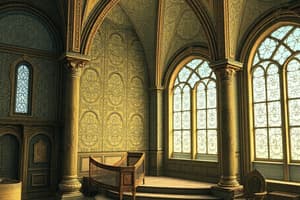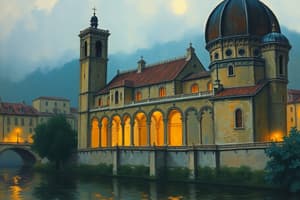Podcast
Questions and Answers
What is the primary significance of the tympanum in churches during the Romanesque period?
What is the primary significance of the tympanum in churches during the Romanesque period?
- To act as a decorative element with no specific meaning
- To provide a place for inscriptions and memorials
- To serve as a structural support for the roof
- To depict biblical narratives and convey theological messages (correct)
Which of the following is a common architectural feature of Romanesque architecture?
Which of the following is a common architectural feature of Romanesque architecture?
- Elaborate spires and tall towers
- Thick walls and rounded arches (correct)
- Flying buttresses
- Large stained glass windows
What type of vaulting was predominantly utilized in Romanesque churches?
What type of vaulting was predominantly utilized in Romanesque churches?
- Cloister vaulting
- Ribbed vaulting
- Groin vaulting
- Barrel vaulting (correct)
Which design element is characteristic of medieval portal design in Romanesque churches?
Which design element is characteristic of medieval portal design in Romanesque churches?
What material was primarily used for the tympanum at Conques?
What material was primarily used for the tympanum at Conques?
What is the significance of the tympanum in Romanesque churches?
What is the significance of the tympanum in Romanesque churches?
Which architectural feature is characteristic of Romanesque style?
Which architectural feature is characteristic of Romanesque style?
What type of vaulting is most commonly associated with Romanesque architecture?
What type of vaulting is most commonly associated with Romanesque architecture?
How did medieval portal designs reflect the values of the time?
How did medieval portal designs reflect the values of the time?
In what way did Romanesque churches differ from their predecessors?
In what way did Romanesque churches differ from their predecessors?
What role did the crusades play in the development of medieval art?
What role did the crusades play in the development of medieval art?
What is a key characteristic of medieval art concerning naturalistic depiction?
What is a key characteristic of medieval art concerning naturalistic depiction?
Which factor contributed significantly to the diversity of approaches in medieval art?
Which factor contributed significantly to the diversity of approaches in medieval art?
What is the purpose of the tympanum in a medieval church portal?
What is the purpose of the tympanum in a medieval church portal?
Which of the following is NOT a characteristic of Romanesque architecture?
Which of the following is NOT a characteristic of Romanesque architecture?
What type of vaulting uses diagonal arches to create rib-like patterns?
What type of vaulting uses diagonal arches to create rib-like patterns?
What best describes the design of arches in Romanesque architecture?
What best describes the design of arches in Romanesque architecture?
Which architectural feature is specifically described as the side posts of a medieval portal?
Which architectural feature is specifically described as the side posts of a medieval portal?
Which element of Romanesque architecture typically serves as a belfry?
Which element of Romanesque architecture typically serves as a belfry?
In Romanesque churches, what is the function of the ambulatory?
In Romanesque churches, what is the function of the ambulatory?
What does the term 'radiating chapels' refer to in Romanesque architecture?
What does the term 'radiating chapels' refer to in Romanesque architecture?
What are small, dark interiors in Romanesque churches primarily due to?
What are small, dark interiors in Romanesque churches primarily due to?
The classification of Romanesque art often includes which of the following prevalent themes?
The classification of Romanesque art often includes which of the following prevalent themes?
Flashcards
Sainte-Foy at Conques Church
Sainte-Foy at Conques Church
A Romanesque church in Conques, France, built approximately between 1050-1130 CE.
Romanesque architecture
Romanesque architecture
A European architectural style of the medieval period.
Tympanum
Tympanum
A semi-circular decorative area found above the entrance of a church.
Bayeux Tapestry
Bayeux Tapestry
Signup and view all the flashcards
Norman Conquest
Norman Conquest
Signup and view all the flashcards
Romanesque Art Period
Romanesque Art Period
Signup and view all the flashcards
Medieval Art Focus
Medieval Art Focus
Signup and view all the flashcards
Medieval Architecture
Medieval Architecture
Signup and view all the flashcards
Art Depiction of Medieval Times
Art Depiction of Medieval Times
Signup and view all the flashcards
Medieval Art Influences
Medieval Art Influences
Signup and view all the flashcards
Church of Sainte-Foy
Church of Sainte-Foy
Signup and view all the flashcards
Iconoclasm
Iconoclasm
Signup and view all the flashcards
Medieval Art Study
Medieval Art Study
Signup and view all the flashcards
Rounded Arches
Rounded Arches
Signup and view all the flashcards
Thick Walls
Thick Walls
Signup and view all the flashcards
Small Windows
Small Windows
Signup and view all the flashcards
Cruciform Plan
Cruciform Plan
Signup and view all the flashcards
Ambulatory
Ambulatory
Signup and view all the flashcards
Arcade
Arcade
Signup and view all the flashcards
Bay
Bay
Signup and view all the flashcards
Campanile
Campanile
Signup and view all the flashcards
Clerestory
Clerestory
Signup and view all the flashcards
Study Notes
Romanesque Art (1000 C.E. - 1200 C.E.)
- Romanesque art, spanning from 1000 to 1200 C.E., is categorized by geographic location, artistic styles, and religious/governmental influences.
- This period shows a variety of approaches to art.
- Interconnections between religions, governments, and artistic influences are prominent.
Enduring Understandings
- Medieval art is studied based on geographic location, styles, and traditions
- Frequent interactions exist between religious, governmental, and artistic influences.
- Influences create variations in approaches to art through the era
Characteristics of the Medieval Period
- This period included Late Antique & Early Christian, Byzantine, Islamic art, Early Medieval, Romanesque, and Gothic art.
Romanesque Art Traits
- Religious expressions (Christianity) were a dominant factor.
- Court life / royalty was an influencing factor of art and construction
- Pursuit of knowledge and learning through trade, worship, and military campaigning (Crusades).
- Architecture focused mostly on religious construction (churches).
- Medieval painting and sculpture avoided naturalistic depictions.
- At times, medieval religions prohibited images, known as Iconoclasm.
Romanesque Art Background
- Europe emerged into major kingdoms with an emphasis on Christianity
- The Crusades represented an invasion of Muslim lands, motivated by retaliation for Muslim expansion in Spain and eastward areas.
- Cities became important trading hubs, enriching the art scene.
- Religious pilgrimages were popular, with prominent destinations like Rome and Jerusalem, generating the construction of Romanesque cathedrals and shrines along pilgrimage roads.
Romanesque Art Background (Social Context)
- A reciprocal relationship existed between lords and peasants. Peasants worked the land owned by lords, and lords guaranteed their security.
- Artists were increasingly part of the middle class.
- Women's artistic roles were restricted to "feminine arts" such as ceramics, weaving, and manuscript decoration.
- Secular art styles did exist, often incorporating symbolism with Christian themes.
Romanesque Architecture Characteristics
- Structures were low, massive, and solid-looking.
- Arches were rounded
- Walls were thick
- Windows were small and placed lower on the walls.
- Ground plans were typically cruciform (cross-shaped) or axial/Basilica-style.
- Interiors primarily were dark
- Vaulting styles included rib, barrel, and groin vaults
- Bell towers (campaniles) were frequently separate structures from the churches.
Romanesque Art Vocabulary
- Arcade: A series of arches supported by columns.
- Bay: Vertical section of a church structured by columns and arches, often with aligned windows.
- Campanile: Bell tower of an Italian building (often separated from the main church).
- Clerestory: The third (or upper) story of a church with windows.
- Jamb: the side posts of a church archway.
- Portal: A doorway, often adorned with carvings and/or sculpture; usually the entrance to a church.
- Rib Vault: A vault where diagonal arches form riblike patterns, typically forming a weblike design
- Radiating Chapels: Projecting chapels arranged around an ambulatory.
- Tympanum: Rounded sculpture placed over a portal, often with narratives or figures.
- Ambulatory: Passageway surrounding the apse of a church.
Romanesque Art Examples
- Church of Sainte-Foy (with Last Judgment tympanum and Reliquary of Sainte-Foy sculpture) at Conques, France.
- Bayeux Tapestry (embroidered wool on linen) depicting historical events, particularly the Norman conquest in 1066.
Studying That Suits You
Use AI to generate personalized quizzes and flashcards to suit your learning preferences.




